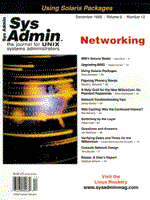
syslog
This last issue for 1999 is dedicated to the topic of networking, and because I recently read some interesting articles concerning the DNS, I thought I'd share a few miscellaneous facts with you. The October issue of IEEE's Computer journal contains an article by Neal Leavitt discussing ICANN's relatively new role in the management of Internet domain names. ICANN, as you may know, stands for Internet Corporation for Assigned Names and Numbers. It is a nongovernmental, nonprofit agency sanctioned by the U.S. Department of Commerce last year to oversee the allocation of domain names and accredit the registrars of those names. Until recently, Network Solutions was the only registrar in the .com, .org, and .net domains and, according to Leavitt's article, their database contains about 75% of the world's registered domain names. Note that, as of July 1999, the Internet Software Consortium's July 1999 Internet Domain Survey (http://www.isc.org) estimates the number of Internet hosts to be minimally 56.2 million, and Network Solutions reportedly registered about 5.3 million names through June of 1999. Leavitt's article explains some of the controversy arising from the transition of control of the master domain name directory (currently held by Network Solutions) to ICANN. In the early 1990s, Network Solutions won an exclusive contract with the NSF to maintain the master domain name directory and to register names ending in .com, .org, and .net. ICANN has now accredited five other organizations (America Online, Register.com, the Council of Internet Registrars, France Télécom/Oléane, and Melbourne IT) and qualified about 65 more as registrars, but because of dispute over ownership of the existing database, Network Solutions has yet to sign ICANN's accreditation agreement. Network Solutions has maintained it needn't sign such an agreement because of the original contract it made with the NSF. Thus, the company continues to register names and allows new registrars to access its database at a rate of $9 per name. In the meantime, ICANN has adopted a uniform dispute resolution policy to be upheld by registrars in cases of naming conflict, and is considering the feasibility of adding new generic top-level domain names, such as .firm, .store, .law, and .arts. It will be interesting to see how this situation plays out over the next few months. In a recent press release, ICANN announced that it had tentatively reached a set of agreements with the U.S. Department of Commerce and Network Solutions to resolve their differences. You can see the terms of this agreement, which will come before the ICANN Board for final consideration at its November meeting, on the ICANN Web site (http://www.icann.org) or visit Network Solutions' site for related pointers (http://www.networksolutions.com/internic/internic.html).
Another item containing some notable data is the Domain Health Survey for August 1999. This survey (distributed by Men & Mice -- http://www.menandmice.com/dnsplace/ \ Specifically, 5000 randomly selected .com Internet zones were tested by the company. Their survey claims that “73.3% of Internet zones have incorrect setup” that could cause host lookup problems. The survey also identifies the most common setup error (29%) as “incorrect delegation configuration”. To see the list of other common errors and read about the methodology, visit the Web site above. These error categories are admittedly broad; nonetheless, it would seem that there's plenty of room for improvement on the road toward minimizing wait time and lookup failures.
Sincerely yours,
|